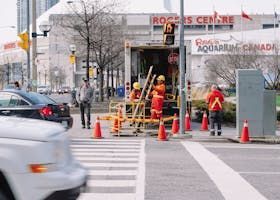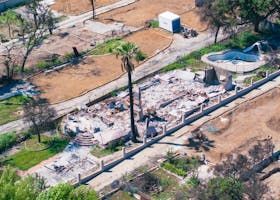The San Francisco real estate market in 2025 represents one of the most dynamic and opportunity-rich housing markets in the United States. With median home prices reaching $1.5 million and the transformative impact of artificial intelligence companies reshaping the economic landscape, understanding current market trends has never been more crucial for buyers, sellers, and investors.
This comprehensive guide examines every aspect of the San Francisco housing market, from current pricing data and neighborhood analysis to future projections and investment strategies. Whether you're a first-time homebuyer, seasoned investor, or industry professional, this analysis provides the insights you need to navigate San Francisco's complex real estate environment successfully.
Current San Francisco Real Estate Market Overview: Key Statistics and Performance Indicators
The San Francisco real estate market in 2025 has demonstrated remarkable resilience and growth, defying earlier predictions of prolonged decline. Current market data reveals a housing market that has not only stabilized but is experiencing renewed momentum across multiple segments.
San Francisco Home Prices: Current Market Data
As of mid-2025, the median home price in San Francisco stands at $1.5 million, representing a 2.7% increase year-over-year. This figure marks a significant turnaround from the price corrections seen throughout 2023 and early 2024, when many analysts predicted continued market softening.
The price per square foot currently averages $976, positioning San Francisco's real estate values 236% higher than the national average. This premium reflects the city's unique combination of limited housing supply, high-income demographics, and global economic significance.
Recent sales data indicates that homes are selling in an average of 24 days, just slightly longer than the 22-day average recorded in 2024. This modest increase in days on market suggests a more balanced buyer-seller dynamic while maintaining competitive market conditions.
San Francisco Housing Market Competition and Buyer Activity
The competitive landscape in San Francisco real estate remains intense, with properties receiving an average of 4 offers per listing. This level of competition, while slightly below pandemic-era peaks, demonstrates sustained buyer interest and market vitality.
Sales volume has increased significantly, with 495 homes sold in June 2025 compared to 399 homes in the same period of 2024. This 24% increase in transaction volume indicates improved market liquidity and buyer confidence.
The AI Revolution: How Artificial Intelligence is Transforming San Francisco Real Estate
Perhaps no single factor has influenced San Francisco's real estate market more profoundly than the explosive growth of artificial intelligence companies. This technological revolution is creating unprecedented demand patterns and reshaping neighborhood dynamics across the city.
AI Company Office Space Expansion and Real Estate Impact
Artificial intelligence companies leased an astounding 3.6 million square feet of office space in San Francisco during 2023, representing a 46% increase from the previous year. Industry projections suggest this figure could reach 12.5 million square feet by 2030, fundamentally altering the city's commercial and residential real estate landscape.
Major AI companies including OpenAI, Anthropic, and Databricks have made substantial real estate commitments. OpenAI's 485,000 square foot lease in Mission Bay alone demonstrates the scale of expansion occurring across the AI sector.
The economic impact extends far beyond commercial real estate. These companies are attracting thousands of highly compensated professionals to San Francisco, creating a ripple effect throughout the residential housing market.
AI Worker Demographics and Housing Demand
AI professionals typically command six-figure salaries, with many receiving substantial equity compensation as their companies achieve billion-dollar valuations. This influx of high-income workers is driving demand across all housing segments, but particularly in the luxury market.
The luxury real estate segment, defined as properties above $5 million, is experiencing remarkable growth. Sotheby's International Realty reports that more homes sold above $20 million in San Francisco during 2025 than in any previous year on record. This surge directly correlates with wealth creation from AI company valuations and stock performance.
Neighborhood Analysis: Where to Buy in San Francisco in 2025
San Francisco's diverse neighborhoods offer varying value propositions, appreciation potential, and investment characteristics. Understanding these local market dynamics is essential for making informed real estate decisions.
High-Value Neighborhoods: Mission Bay, SoMa, and Financial District
Mission Bay has emerged as a central hub for AI and biotech companies, with significant corporate presence driving both commercial and residential demand. The neighborhood's modern infrastructure, proximity to public transportation, and concentration of high-paying jobs make it increasingly attractive to professionals.
South of Market (SoMa) continues to attract AI startups and established tech companies. The area's industrial-to-residential conversion projects have created unique living opportunities, while its central location provides easy access to both downtown amenities and Silicon Valley via public transit.
The Financial District, while traditionally commercial, is seeing increased residential interest as more companies implement hybrid work arrangements. Converted office buildings and new residential developments are creating housing options for professionals seeking urban convenience.
Emerging Value Neighborhoods: Bernal Heights, Richmond, and Sunset Districts
Bernal Heights offers exceptional value for buyers seeking San Francisco living at more accessible price points. The neighborhood's community-oriented atmosphere, local businesses, and improved transportation connections make it increasingly popular among young professionals and families.
The Richmond District provides excellent value with its diverse dining scene, proximity to Golden Gate Park, and relatively affordable housing stock. Recent infrastructure improvements and new business development are contributing to steady appreciation.
The Sunset District, particularly the Outer Sunset, has become popular among tech professionals seeking work-life balance. Proximity to Golden Gate Park, the Great Highway, and excellent outdoor recreation opportunities make it attractive to active professionals.
Hayes Valley: The Heart of "Cerebral Valley"
Hayes Valley has earned the nickname "Cerebral Valley" due to its concentration of AI startups and venture capital firms. This central location offers walkability, cultural amenities, and proximity to both downtown and the Mission District.
The neighborhood's transformation from a post-freeway removal area to a thriving business and residential district demonstrates San Francisco's capacity for urban renewal. Current real estate prices reflect this transformation while still offering relative value compared to traditional tech corridors.
San Francisco Real Estate Market Predictions: Expert Forecasts for 2025-2026
Industry experts, economists, and real estate professionals offer cautiously optimistic predictions for San Francisco's housing market trajectory over the next 12-24 months.
Interest Rate Projections and Mortgage Market Conditions
Most economists predict interest rates will stabilize in the 6-7% range throughout 2025, with potential for modest decreases in 2026. San Francisco benefits from non-conforming loan rates that typically run approximately 1% below national averages due to high median home values.
This rate advantage can translate to significant monthly savings for San Francisco buyers. On a $1.5 million home purchase, a 1% rate difference can save buyers $1,000+ monthly in mortgage payments.
Ten-year ARM products are gaining popularity among San Francisco buyers as an alternative to traditional 30-year fixed mortgages, offering potentially better terms for buyers planning shorter holding periods.
Price Appreciation Forecasts and Market Growth
Real estate professionals predict modest price appreciation of 1-3% annually for most San Francisco market segments. However, the AI boom is expected to add an additional 1-2% premium to appreciation rates, particularly in neighborhoods with high concentrations of tech workers.
The luxury market segment is projected to outperform significantly, driven by continued wealth creation in the technology sector. Properties above $5 million are expected to see appreciation rates of 4-6% annually.
Some analysts suggest a potential market softening with predictions of a 1.8% decline through November 2025, but this would represent a healthy market correction rather than a significant downturn.
The San Francisco Rental Market: Unprecedented Demand and Rising Costs
San Francisco's rental market tells a dramatic story of transformation, driven primarily by AI professionals and supporting industries creating intense competition for quality housing.
Rental Rate Increases and Market Competition
Leasing agents report minimum rent increases of 10% across their portfolios, with many premium properties experiencing year-over-year increases of 50% or more. A recent example includes a Pacific Heights property that now rents for $9,800 monthly, representing a 50% increase from the previous year.
The competitive landscape has become so intense that securing quality rental housing requires the same level of preparation and speed typically associated with venture capital funding rounds. Prospective tenants often compete with dozens of applications for desirable properties.
One-bedroom apartments in desirable neighborhoods now command rents exceeding $3,250 monthly, with vacancy rates trending near 3%. This tight supply-demand balance heavily favors landlords and property owners.
Corporate Housing and Alternative Rental Models
AI startups are increasingly providing corporate housing solutions for employees, recognizing that housing challenges can impact productivity and recruitment. Some companies offer temporary housing stipends or partner with corporate housing providers.
Co-living arrangements and "hacker houses" have emerged as alternative solutions, particularly for younger professionals and startup employees. These arrangements offer cost-effective housing while building professional networks.
Investment Strategies: Maximizing Returns in San Francisco Real Estate
San Francisco real estate presents unique investment opportunities and challenges that require sophisticated analysis and strategic planning.
Residential Investment Property Analysis
While rental yields in San Francisco may not match other markets, the city offers three compelling investment advantages: strong appreciation potential, market stability, and wealth preservation characteristics.
Historical data demonstrates consistent long-term growth, with the AI boom adding additional upward pressure. San Francisco's global desirability and limited supply create defensive characteristics during market downturns.
High-net-worth individuals increasingly view San Francisco real estate as a portfolio diversification strategy, particularly given the city's role as a global technology and financial center.
Multi-Unit Properties and Investment Opportunities
Three-unit buildings have become particularly attractive to investors and owner-occupants. These properties allow for owner occupancy in one unit while generating rental income from the remaining units, helping offset mortgage costs.
Some buyers are utilizing the flexibility of multi-unit properties creatively, using one unit for primary residence, another for extended family, and the third as a home office or short-term rental.
Construction Costs and Renovation Considerations
Current construction costs range from $1,100 to $2,000+ per square foot, making extensively renovated properties often more cost-effective than major renovation projects. Labor shortages and material costs continue to impact construction timelines and budgets.
Buyers should carefully evaluate renovation projects against purchasing move-in ready properties, particularly in competitive market conditions where time to close can be crucial.
San Francisco's Urban Renaissance: Safety, Infrastructure, and Quality of Life Improvements
Beyond market fundamentals, San Francisco is experiencing a remarkable urban transformation that supports property values across all market segments.
Public Safety Improvements and Community Development
Under Mayor Daniel Lurie's leadership, San Francisco has achieved significant improvements in public safety and quality of life. Crime has dropped to a 23-year low, with car break-ins falling 50% in 2024.
The tent count has reached its lowest level since records began, while office leasing activity has hit six-year highs. These improvements create positive feedback loops that support property values and neighborhood desirability.
Visible improvements include transformed public spaces, increased police presence in commercial districts, and community programs addressing homelessness and public safety concerns.
Infrastructure Investment and Transportation Improvements
Ongoing infrastructure investments are improving connectivity between neighborhoods and reducing commute times to Silicon Valley. Public transit improvements and bicycle infrastructure enhance the attractiveness of various neighborhoods.
The completion of major development projects in Mission Bay, SoMa, and other districts is creating new housing supply while improving neighborhood amenities and services.
Challenges and Considerations for San Francisco Real Estate in 2025
Despite positive trends, several factors require careful consideration for anyone involved in San Francisco real estate.
Affordability and Housing Supply Constraints
San Francisco's high cost of living continues to challenge many potential buyers and renters. The median home price of $1.5 million puts homeownership out of reach for many middle-income residents.
Limited housing supply remains a fundamental challenge, with new construction unable to keep pace with job growth and population increases. Zoning restrictions and lengthy approval processes continue to constrain housing development.
Condominium Market Considerations
Condominium investments face particular challenges compared to single-family homes. HOA dues are rising significantly due to increased insurance and operating costs, with monthly fees of $1,000+ becoming common in larger buildings.
Buyers must factor higher HOA costs into loan qualification calculations, potentially reducing purchasing power compared to single-family home purchases.
Short-Term Lease Trends in Commercial Real Estate
Many AI startups prefer short-term leases (63% under three years), creating both opportunities and uncertainties in the commercial real estate sector. This trend reflects the fast-moving nature of the technology industry but may impact long-term commercial property values.
Frequently Asked Questions About San Francisco Real Estate in 2025
Is now a good time to buy real estate in San Francisco?
For buyers with long-term investment horizons, current market conditions offer compelling opportunities. The combination of stabilizing interest rates, AI-driven economic growth, and improved urban conditions creates favorable fundamentals for property appreciation.
Which San Francisco neighborhoods offer the best investment potential?
Neighborhoods with strong AI company presence (Mission Bay, SoMa, Hayes Valley) and emerging value areas (Bernal Heights, Outer Sunset, Richmond) offer different risk-reward profiles. The best choice depends on investment timeline, budget, and risk tolerance.
How is the AI boom affecting San Francisco real estate prices?
The AI boom is adding an estimated 1-2% premium to annual appreciation rates while driving significant rental rate increases. The luxury market is experiencing the most dramatic impact, with record sales above $20 million.
What are the current rental market conditions in San Francisco?
Rental market conditions are extremely competitive, with minimum 10% annual increases and some properties seeing 50% year-over-year growth. Low vacancy rates and high demand from AI professionals are driving this trend.
Should I wait for prices to drop before buying in San Francisco?
Most experts believe significant price drops are unlikely given strong economic fundamentals, limited supply, and continued tech sector growth. Waiting may result in higher prices and more competition.
Conclusion: Navigating San Francisco's Real Estate Market in 2025
The San Francisco real estate market in 2025 represents a compelling opportunity for informed buyers and investors. The convergence of AI-driven economic growth, urban renaissance initiatives, and stabilizing market conditions creates a unique environment for real estate investment and homeownership.
While challenges including high prices, limited supply, and intense competition persist, the fundamental drivers supporting San Francisco's real estate market remain strong. The city's role as the global center for artificial intelligence development, combined with its established position in finance and technology, provides a foundation for continued property value growth.
Success in San Francisco's real estate market requires comprehensive market knowledge, strategic planning, and often rapid decision-making. Working with experienced local professionals who understand neighborhood dynamics, financing options, and market trends is essential for achieving optimal outcomes.
As San Francisco continues to evolve and adapt to technological change and urban challenges, real estate will remain a cornerstone investment for those seeking exposure to one of the world's most dynamic and innovative cities. The market conditions of 2025 may well be remembered as the beginning of another transformative cycle in San Francisco's remarkable real estate history.
For those ready to enter this market, the combination of current opportunities, future growth potential, and the city's unmatched position in the global economy makes San Francisco real estate an investment worthy of serious consideration.











